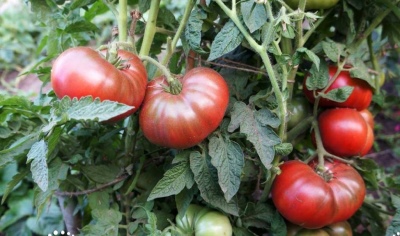
- Name synonyms: Dwarf Wild Fred, Dwarf Wild Fred
- Category: grade
- Growth type: determinant
- Appointment: universal
- Ripening period: mid-season
- Growing conditions: for open ground, for film greenhouses
- Bush size: undersized
- Bush height, cm: 50-70
- Leaves: wrinkled
- Ripe fruit color: purple chocolate
Low-growing varieties of tomatoes are especially loved by gardeners, because they can be grown in confined spaces. Wild Fred is a synonym for Dwarf. Wild Fred is a bright representative of a very successful line of dwarf tomatoes from US breeders.
Breeding history
The variety was introduced for sale and breeding in 2010 by the American Tomato Growers Supply Company. It appeared as a result of crossing New Big Dwarf and Carbon. Breeder Bruce Bradshaw worked on the breeding. Due to the peculiarities of the color, the variety entered the family with the name Sleazy (sloppy). The novelty is part of a large Dwarf Tomato Project to create high-yielding and sustainable dwarf tomato varieties.
The authors of the project, Craig LeHullier (USA) and Patrina Nuske-Small (Australia), conceived it, realizing how limited consumers are in choosing compact varieties of tomatoes for small areas, for growing on balconies and in pots. For the first varieties, the names of the dwarfs from the famous "Snow White" were taken. By 2019, the collection of dwarf tomatoes consisted of more than 100 items.
By naming one of the strains Dwarf Wild Fred, Craig LeHullier paid tribute to his father, who inspired him to grow plants as a child.
Description of the variety
Wild Fred is a versatile, productive, mid-season dwarf variety with a bush of determinate growth and sweet fruits of medium size and red-chocolate color with a purple undertone. The bush forms 1-2 stems with wrinkled leaves resembling potato leaves.
The main qualities of the fruit
Wild Fred tomatoes have a flattened flat-round shape and an amazing bicolor color. As it ripens, the shades change from dark pink to brown-violet, and a dark green "crown" is formed near the stalk. Fruit weight ranges from 80 to 200 g (rarely up to 300 g), the average weight is 150 g.
On the cut of a tomato, rather thick walls are visible, a small number of seeds and a beautiful, juicy, buttery pulp.
Transportability and keeping quality of ripe fruits is low. This is not the most suitable variety for preserving and pickling whole tomatoes.
Taste characteristics
The fruits are distinguished by a strong pleasant aroma and harmonious taste: sweet with a slight sourness. Wild Fred is used for making sauces, lecho, ketchup, juice, but the taste is most vividly revealed when fresh: in vegetable slices and salads.
Ripening and fruiting
This mid-season variety yields within 110-125 days from germination. The plant forms a strong, spreading, undersized bush (50-70 cm), on which about 6-7 clusters with 3-6 tomatoes on each are formed. Fruit picking usually takes place in mid to late August.
Yield
One of the main objectives of the Tomatoes-Gnomes project was to create low-growing but highly productive varieties. The yield of this variety is high. Up to 12-15 kg are harvested from an area of 1m².
The timing of planting seedlings and planting in the ground
Sowing the seeds of Wild Fred is done about 2 months before planting in the ground.In late February - early March, the seeds are placed in a common container, small cups, or sprouted on coconut or peat tablets. When 2-4 leaves appear, the plants are dived into separate containers or transplanted into large pots.
It is recommended to grow tomato seedlings in good lighting and harden, "accustoming" to the sun and changing temperatures, although even with insufficient illumination, this variety does not stretch. On a plot in open ground, seedlings are planted in May (in a greenhouse, on a balcony - at the end of April), when the danger of return frosts has already passed.

Growing tomato seedlings is an extremely important process, because it largely depends on whether the gardener can harvest at all. All aspects must be taken into account, from seedbed preparation to planting in the ground.
Landing scheme
To avoid thickening, it is recommended to plant 4-5 bushes per 1 m² for this variety.

Growing and caring
Wild Fred is loved for its amazing unpretentiousness: even an inexperienced gardener can grow him. It is better not to overfeed the soil under the seedlings: you can add ash and complex mineral fertilizer.
The bushes practically do not form stepchildren, it is also not necessary to tie them up. If desired, if the brushes are strongly inclined to the ground, you can lay black agrofibre on which the tomatoes will ripen.
The plant can withstand weather changes and summer heat. Wild Fred will delight you with good health even in the absence of regular watering, suitable for summer residents who only visit their garden.
The variety does not have strict zoning, grows well and bears fruit in various regions: in the Moscow region, Krasnodar Territory, beyond the Urals.




A plant needs different micronutrients at each stage of growth. All fertilizers can be divided into two groups: mineral and organic. Folk remedies are often used: iodine, yeast, bird droppings, eggshells.
It is important to observe the rate and period of feeding. This also applies to folk remedies and organic fertilizers.
Disease and pest resistance
The growers of the gnome tomato range have succeeded in reducing the susceptibility of these compact varieties to common tomato diseases and pests.
The usual agricultural activities: disinfection and loosening of the soil, weeding, preventive treatment with fungicides and natural preparations will help protect this magnificent variety, and it will gratefully present a tasty and bountiful harvest.



























































































